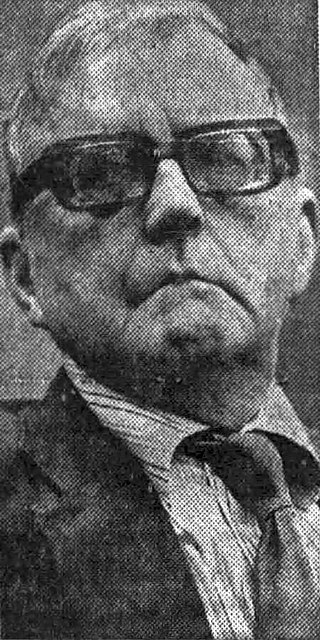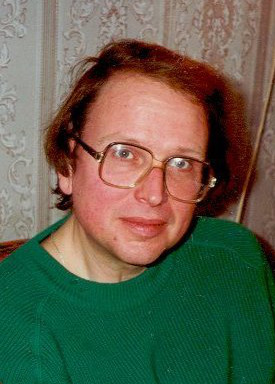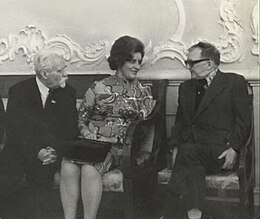
Dmitri Dmitriyevich Shostakovich was a Soviet-era Russian composer and pianist who became internationally known after the premiere of his First Symphony in 1926 and thereafter was regarded as a major composer.
Dmitri Shostakovich's String Quartet No. 8 in C minor, Op. 110, was written in three days.
Dmitri Shostakovich wrote his Symphony No. 2 in B major, Op. 14, subtitled To October, for the 10th anniversary of the October Revolution. It was first performed by the Leningrad Philharmonic Orchestra and the Academy Capella Choir under Nikolai Malko, on 5 November 1927. After the premiere, Shostakovich made some revisions to the score, and this final version was first played in Moscow later in 1927 under the baton of Konstantin Saradzhev. It was also the first time any version of the work had been played in Moscow.
Dmitri Shostakovich composed his Symphony No. 4 in C minor, Op. 43, between September 1935 and May 1936, after abandoning some preliminary sketch material. In January 1936, halfway through this period, Pravda—under direct orders from Joseph Stalin—published an editorial "Muddle Instead of Music" that denounced the composer and targeted his opera Lady Macbeth of Mtsensk. Despite this attack and the political climate of the time, Shostakovich completed the symphony and planned its premiere for December 1936 in Leningrad. After rehearsals began, the orchestra's management cancelled the performance, offering a statement that Shostakovich had withdrawn the work. He may have agreed to withdraw it to relieve orchestra officials of responsibility. The symphony was premiered on 30 December 1961 by the Moscow Philharmonic Orchestra led by Kirill Kondrashin.
The Symphony No. 5 in D minor, Op. 47, by Dmitri Shostakovich is a work for orchestra composed between April and July 1937. Its first performance was on November 21, 1937, in Leningrad by the Leningrad Philharmonic Orchestra under Yevgeny Mravinsky. The premiere was a "triumphal success" that appealed to both the public and official critics, receiving an ovation that lasted well over half an hour.
The Symphony No. 8 in C minor, Op. 65, by Dmitri Shostakovich was written in the summer of 1943, and first performed on 4 November of that year by the USSR Symphony Orchestra under Yevgeny Mravinsky, to whom the work is dedicated. It briefly was nicknamed the "Stalingrad Symphony" following the first performance outside the Soviet Union in 1944.
The Symphony No. 10 in E minor, Op. 93, by Dmitri Shostakovich was premiered by the Leningrad Philharmonic Orchestra under Yevgeny Mravinsky on 17 December 1953. It is not clear when it was written. According to the composer, the symphony was composed between July and October 1953, but Tatiana Nikolayeva stated that it was completed in 1951. Sketches for some of the material date from 1946.

The Symphony No. 13 in B-flat minor, Op. 113 for bass soloist, bass chorus, and large orchestra was composed by Dmitri Shostakovich in 1962. It consists of five movements, each a setting of a Yevgeny Yevtushenko poem that describes aspects of Soviet history and life. Although the symphony is commonly referred to by the nickname Babi Yar, no such subtitle is designated in Shostakovich's manuscript score.
The Cello Concerto No. 1 in E-flat major, Op. 107, was composed in 1959 by Dmitri Shostakovich. Shostakovich wrote the work for his friend Mstislav Rostropovich, who committed it to memory in four days. He premiered it on October 4, 1959, at the Large Hall of the Leningrad Conservatory with the Leningrad Philharmonic Orchestra conducted by Yevgeny Mravinsky. The first recording was made in two days following the premiere by Rostropovich and the Moscow Philharmonic Orchestra conducted by Aleksandr Gauk.
Dmitri Shostakovich wrote his Cello Concerto No. 2, Op. 126, in 1966 in the Crimea. Like the first concerto, it was written for Mstislav Rostropovich, who gave the premiere in Moscow under Yevgeny Svetlanov on 25 September 1966 at the composer's 60th birthday concert. The concerto is sometimes listed as in the key of G, but the score gives no such indication.

The String Quartet No. 15 in E-flat minor, Op. 144 by Dmitri Shostakovich is the composer's last. It was his first quartet since the Sixth which did not bear a dedication.
DSCH is a musical motif used by the composer Dmitri Shostakovich to represent himself. It is a musical cryptogram in the manner of the BACH motif, consisting of the notes D, E-flat, C, B natural, or in German musical notation D, Es, C, H, thus standing for the composer's initials in German transliteration: D. Sch..

The Piano Sonata No. 2 in B minor, Op. 61 by Dmitri Shostakovich, the last of his piano sonatas, was composed in early 1943. It was his first solo piano composition since 1933, as well as his second attempt at composing a piano sonata in the key of B minor.

Alexander Ivashkin, was a Russian cellist, writer, academic and conductor. He was a professor of music and the Chair of Performance Studies at Goldsmiths, University of London since 1999, the director of the Centre for Russian Music, and the curator of the Alfred Schnittke Archive. In 1996, he published the first English-language biography of the composer Alfred Schnittke.
The Sonata for Viola and Piano, Op. 147, is the last composition by Dmitri Shostakovich. It was completed on July 5, 1975, weeks before his death. It is dedicated to Fyodor Druzhinin, violist of the Beethoven Quartet.

The Five Fragments, Op. 42 is a suite for small orchestra composed on June 9, 1935, by Dmitri Shostakovich. It was the only work, apart from film music, that he composed that year. He approached it as preparatory work for the composition of the final version of his Symphony No. 4.

October, Op. 131, is a symphonic poem composed by Dmitri Shostakovich to commemorate the fiftieth anniversary of the October Revolution in 1967. He was spurred to compose the work after reencountering his score for the Vasilyev brothers' 1937 film Volochayev Days, reusing its "Partisan Song" in October. Although Shostakovich completed the work quickly, the process of writing it fatigued him physically because of his deteriorating motor functions.

The "March of the Soviet Militia", Op. 139 is a march for military band composed in 1970 by Dmitri Shostakovich.

The Four Verses of Captain Lebyadkin by Dmitri Shostakovich is a song cycle composed in 1974. It is his final vocal work.

The Six Poems by Marina Tsvetayeva: Suite for Contralto and Piano, Op. 143 is a song cycle by Dmitri Shostakovich. It was composed in 1973 and originally scored for contralto and piano. In 1974, the composer produced an arrangement for contralto and chamber orchestra which he designated as Op. 143a.










